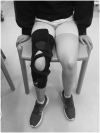Current concepts in the treatment of first-time patella dislocation in children and adolescents
- PMID: 36755554
- PMCID: PMC9900011
- DOI: 10.1177/18632521221149060
Current concepts in the treatment of first-time patella dislocation in children and adolescents
Abstract
Background: Lateral dislocation of the patella is a common injury in children. It can occur in previously healthy and anatomically normal knees, but there are several abnormalities that predispose to patellar instability. Magnetic resonance imaging is an essential part of assessing for associated injuries and risk of further instability. Treatment aims to prevent redislocation, residual instability, osteoarthritis, and allow return to previous activities. The purpose of this review was to assess evidence for management of first-time patella dislocation in children and adolescents.
Methods: Literature review was performed, accompanied by the current best practice by the authors.
Results: Non-operative treatment is preferred, except where there are associated injuries such as osteochondral fractures that would benefit from surgery. The exact method of ideal non-operative management is not clearly defined but should focus on restoration of range of movement and strength with bracing as indicated. There seems to be a trend toward operative intervention that may well be inappropriate.
Conclusion: Further prospective studies are required with focus on the younger patient to fully understand if there is an at-risk group that would benefit from early surgery.
Level of evidence: level III.
Keywords: First-time dislocation; children and adolescents; patella; sport injury; treatment options.
© The Author(s) 2023.
Conflict of interest statement
The author(s) declared the following potential conflicts of interest with respect to the research, authorship, and/or publication of this article: J.S. is a member of the International Editorial Board of Journal of Children’s Orthopedics. Otherwise, there are no conflicting interests.
Figures


Similar articles
-
Acute patellar dislocation in children and adolescents. Surgical technique.J Bone Joint Surg Am. 2009 Mar 1;91 Suppl 2 Pt 1:139-45. doi: 10.2106/JBJS.H.01289. J Bone Joint Surg Am. 2009. PMID: 19255206 Clinical Trial.
-
Acute patellar dislocation in children and adolescents: a randomized clinical trial.J Bone Joint Surg Am. 2008 Mar;90(3):463-70. doi: 10.2106/JBJS.G.00072. J Bone Joint Surg Am. 2008. PMID: 18310694 Clinical Trial.
-
Adolescent and Caregiver-derived Utilities for Traumatic Patella Dislocation Health States.J Pediatr Orthop. 2019 Nov/Dec;39(10):e755-e760. doi: 10.1097/BPO.0000000000001341. J Pediatr Orthop. 2019. PMID: 30688843
-
Current concepts of lateral patella dislocation.Clin Sports Med. 2002 Jul;21(3):499-519. doi: 10.1016/s0278-5919(02)00031-5. Clin Sports Med. 2002. PMID: 12365240 Review.
-
Current Concepts for Patellar Dislocation.Arch Trauma Res. 2015 Sep 1;4(3):e29301. doi: 10.5812/atr.29301. eCollection 2015 Sep. Arch Trauma Res. 2015. PMID: 26566512 Free PMC article. Review.
Cited by
-
Comparison of five different fluoroscopic methods for identifying the MPFL femoral footprint.Arch Orthop Trauma Surg. 2024 Apr;144(4):1675-1684. doi: 10.1007/s00402-024-05213-9. Epub 2024 Feb 24. Arch Orthop Trauma Surg. 2024. PMID: 38400901 Free PMC article.
-
Reliability and Validity of an Ultrasound-Derived Measure for Axial Patellofemoral Alignment.Orthop J Sports Med. 2024 Oct 11;12(10):23259671241281362. doi: 10.1177/23259671241281362. eCollection 2024 Oct. Orthop J Sports Med. 2024. PMID: 39399767 Free PMC article.
-
Operative Repair of Medial Patellofemoral Ligament Injury Versus Knee Bracing in Acute First-Time Traumatic Patellar Dislocation: A Systematic Review and Meta-Analysis.Cureus. 2024 Nov 19;16(11):e73984. doi: 10.7759/cureus.73984. eCollection 2024 Nov. Cureus. 2024. PMID: 39703292 Free PMC article. Review.
-
Midterm Outcomes of Medial Patellofemoral Ligament Reconstruction in Adolescent Athletes: Comparison Between Acute and Recurrent Patella Dislocation.J Clin Med. 2025 Jul 9;14(14):4881. doi: 10.3390/jcm14144881. J Clin Med. 2025. PMID: 40725574 Free PMC article.
-
Pediatric osteochondral fractures: clinical insights associate early diagnosis to early rehabilitation via arthroscopy.Eur J Orthop Surg Traumatol. 2024 Apr;34(3):1657-1665. doi: 10.1007/s00590-024-03852-7. Epub 2024 Feb 20. Eur J Orthop Surg Traumatol. 2024. PMID: 38376585 Free PMC article.
References
-
- Buchner M, Baudendistel B, Sabo D, et al.. Acute traumatic primary patellar dislocation: long-term results comparing conservative and surgical treatment. Clin J Sport Med 2005; 15(2): 62–66. - PubMed
-
- Sanders TL, Pareek A, Hewett TE, et al.. High rate of recurrent patellar dislocation in skeletally immature patients: a long-term population-based study. Knee Surg Sports Traumatol Arthrosc 2018; 26(4): 1037–1043. - PubMed
-
- Longo UG, Ciuffreda M, Locher J, et al.. Treatment of primary acute patellar dislocation: systematic review and quantitative synthesis of the literature. Clin J Sport Med 2017; 27(6): 511–523. - PubMed
Publication types
LinkOut - more resources
Full Text Sources
Research Materials

